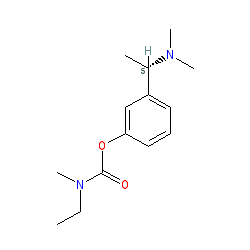|
Synonyms: Ena 713 free base | Exelon®
rivastigmine is an approved drug (FDA (2000), EMA (1998))
Compound class:
Synthetic organic
Comment: Marketed formulations may contain rivastigmine hydrogen tartrate (PubChem CID 14254240).
Ligand Activity Visualisation ChartsThese are box plot that provide a unique visualisation, summarising all the activity data for a ligand taken from ChEMBL and GtoPdb across multiple targets and species. Click on a plot to see the median, interquartile range, low and high data points. A value of zero indicates that no data are available. A separate chart is created for each target, and where possible the algorithm tries to merge ChEMBL and GtoPdb targets by matching them on name and UniProt accession, for each available species. However, please note that inconsistency in naming of targets may lead to data for the same target being reported across multiple charts. ✖
View more information in the IUPHAR Pharmacology Education Project: rivastigmine |
|
|||||||||||||||||||||||||||||||||||
| No information available. |
Summary of Clinical Use  |
| Used in the treatment of Alzheimer's disease [1]. Rivastigmine-induced cholinesterase inhibition may also be beneficial in vascular cognitive impairment (VCI). A Phase 2 clinical trial in patients with Parkinson's disease appears to show that rivastigmine (compared to placebo) improves gait dysfunction and decreases the likelihood of falls [2], by ameliorating the underlying cholinergic deficit which contributes to gait and cognitive dysfunction in Parkinson's sufferers. This study is registered with the ISRCTN registry (ID ISRCTN19880883). The study does not address the question of whether the difference between the rivastigmine and placebo groups was due to increased falls in the placebo group as opposed to decreased falls in the rivastigmine group. |
External links  |
|
For extended ADME data see the following: Electronic Medicines Compendium (eMC) Drugs.com European Medicines Agency (EMA) |








